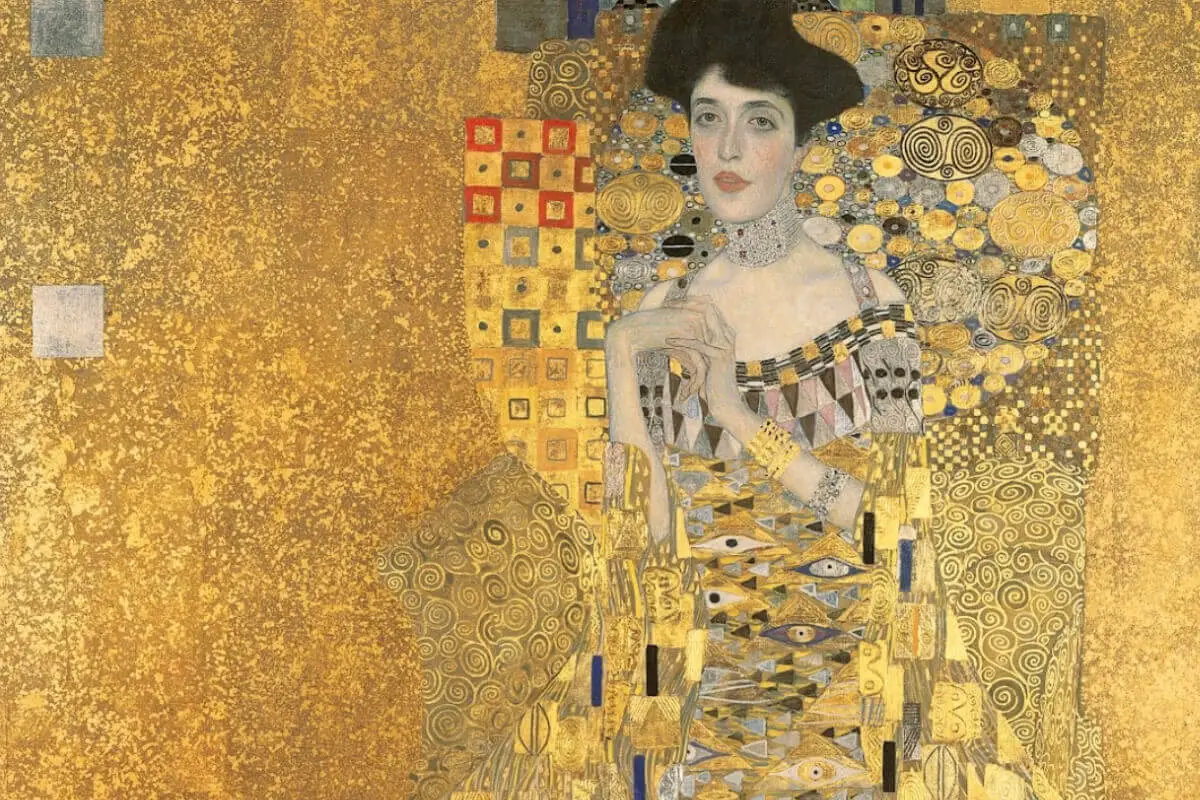Gustav Klimt, a pioneer beyond his time, advocated for artistic freedom and pushed the boundaries of traditional art standards through his unique and sometimes controversial work. Emerging from a humble background, Klimt navigated the dynamic socio-political climate of his era, harnessing it as fuel for his artistry and contributing definitively to the field of visual arts.
As one delves into the progression of Klimt’s life, from his early inspiration to his later years, one uncovers the profound links between his journey and his extraordinary artistry.
Gustav Klimt’s Early Life and Inspiration
An adage says, ‘Art imitates life,‘ often encapsulating the profound connection between an artist’s personal experiences and the art they create. Few stories embody this sentiment more powerfully than that of Gustav Klimt, the acclaimed Austrian symbolist painter.
His early life experiences provided the thematic foundations of his illustrious artistic career that he dutifully cultivated and ultimately left an indelible mark in art history.
Born in 1862, Gustav Klimt was the son of a gold engraver and a musical mother, establishing his first brush with the universe of art. Growing up in the economically challenged outskirts of Vienna, Klimt’s childhood was far from wealthy, yet he was introduced to the discipline of meticulous craftsmanship and the sublime harmony of music early on.
These elements would later feature prominently in his symbolic and ornamental style, reflecting an art that was as beautiful and melodic as it was profoundly meaningful.
Klimt’s father’s career as a gold engraver was of notable significance. Despite their frugal lifestyle, the diverse range of gold and silver artifacts surrounding Klimt was a notable source of inspiration.
This fascination with metallic hues and textures was evident in Klimt’s later works, where gold, silver, and intricate texture became a defining element. One can’t help but marvel at the shimmer of “The Kiss” or the profound symbolism in “The Tree of Life” without acknowledging the early influences.
Klimt’s early education at the Vienna School of Arts and Crafts further paved the way for him to experiment with and eventually master different art forms – from architectural painting to murals. The school emphasized functional and aesthetic aspects of crafts and design, reflected in the decorative and architectural elements in Klimt’s later work.
It is essential to mention the Vienna Secession movement. The deviation from traditional art styles mirrored Klimt’s break from norms and a quest for individual freedom.
His mother’s passion for music and his immersion in Vienna’s thriving cultural scene saw Klimt create some of the best iconic pieces that embrace the spirit of the Secession movement. They were symphonies on canvas and walls, combining color, pattern, and unbounded forms in a harmonious composition that challenged the artistic conventions of that era.
Strikingly, Klimt’s complicated relationship with women undeniably influenced many of his works. Having been raised in a female-dominated household, Klimt was no stranger to the strength and resilience of women.
His portrayal of women in paintings was discordantly refreshing in a male-dominated society. He idealized no one; he objectified no one. His women were sensuous yet intense, mythical but real, and this apparent dichotomy brought a unique and provocative element to his artistic genius and style.
Therefore, as one peers through the looking glass of Gustav Klimt’s early life, it becomes evident how his formative growth shaped his artistic language.
His leanings toward symbolism, his passion for the ornate, and his love for rebellious femininity are all sourced from the wells of his childhood, his exposures, and personal experiences, thus making him a torchbearer in the historical lineage of artists who wore their lives on their canvas.
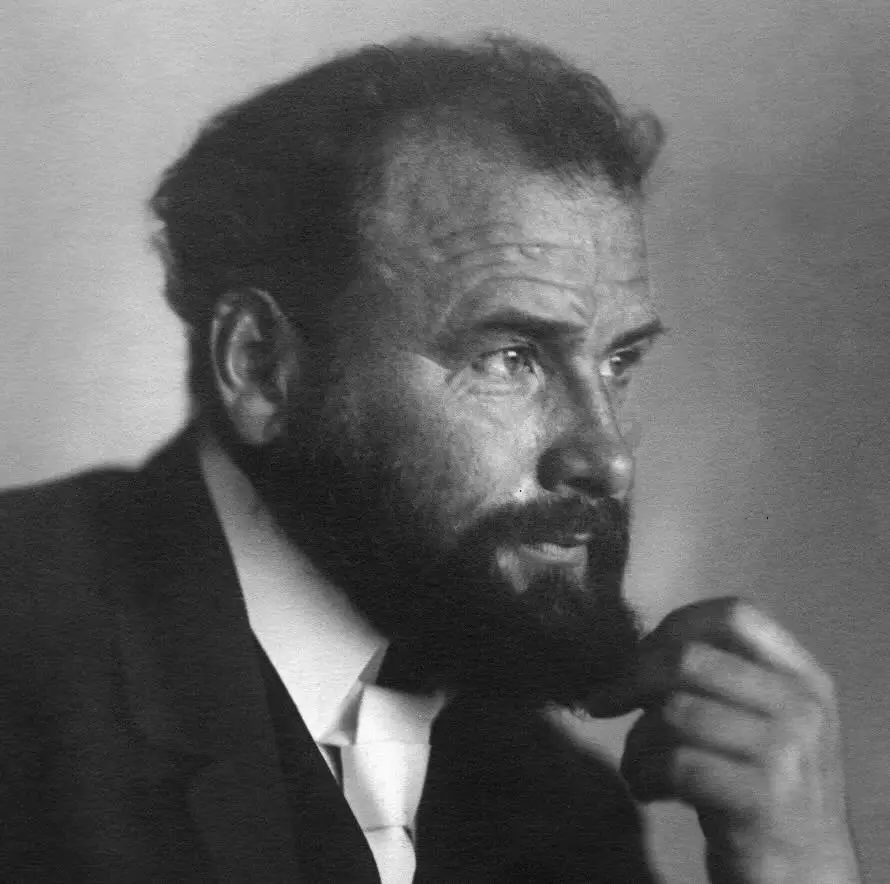
Gustav Klimt’s Artistic Style and Major Works
Moving on from previously discussed, it’s entirely necessary to explore the essentials of Gustav Klimt’s unique style and the works that have had a resounding impact on the art world.
Indeed, Gustav Klimt’s style was marked by a bold departure from traditional art norms and his uncompromising devotion to aesthetic beauty. Yet, his eye for beauty went beyond superficiality; he delved deep beneath the surface to capture the profound complexities of existence and the human condition.
He seamlessly incorporated eroticism, psychology, and symbolism to create artworks that posed an exciting challenge to the status quo of the Viennese society of his time.
A defining element of Klimt’s artistic style was his incredible use of gold leaf, a technique inspired by his father and reminiscent of ancient Byzantine art, further affirming his work’s brilliance and uniqueness.

The shimmering richness, seen in pieces like “The Kiss” and “Portrait of Adele Bloch-Bauer I,” serves more than just a decorative purpose. It lends a larger-than-life personality to his subjects, placing them under a radiant spotlight while alluding to deeper themes of passion, luxury, and mortality.
Moreover, pattern and ornamentation were not just stylistic choices but vital tools he used for storytelling. Klimt painted his figures with swirling, fluid lines, intricate patterns, and vibrant colors – a fusion that advanced his style beyond decorative to symbolic. Characters swathed in intricate patterns often symbolized emotional states, societal roles, or abstract concepts.
His most celebrated works showcase these signature techniques. “The Kiss” is a masterpiece widely recognized for its ornate, accurate gold details and Klimt’s signature mosaic-like floral patterns.
This breathtaking painting captures an intimate, sensual moment shared between two lovers, a common theme in many of his works, symbolizing love’s sweetness and transience.
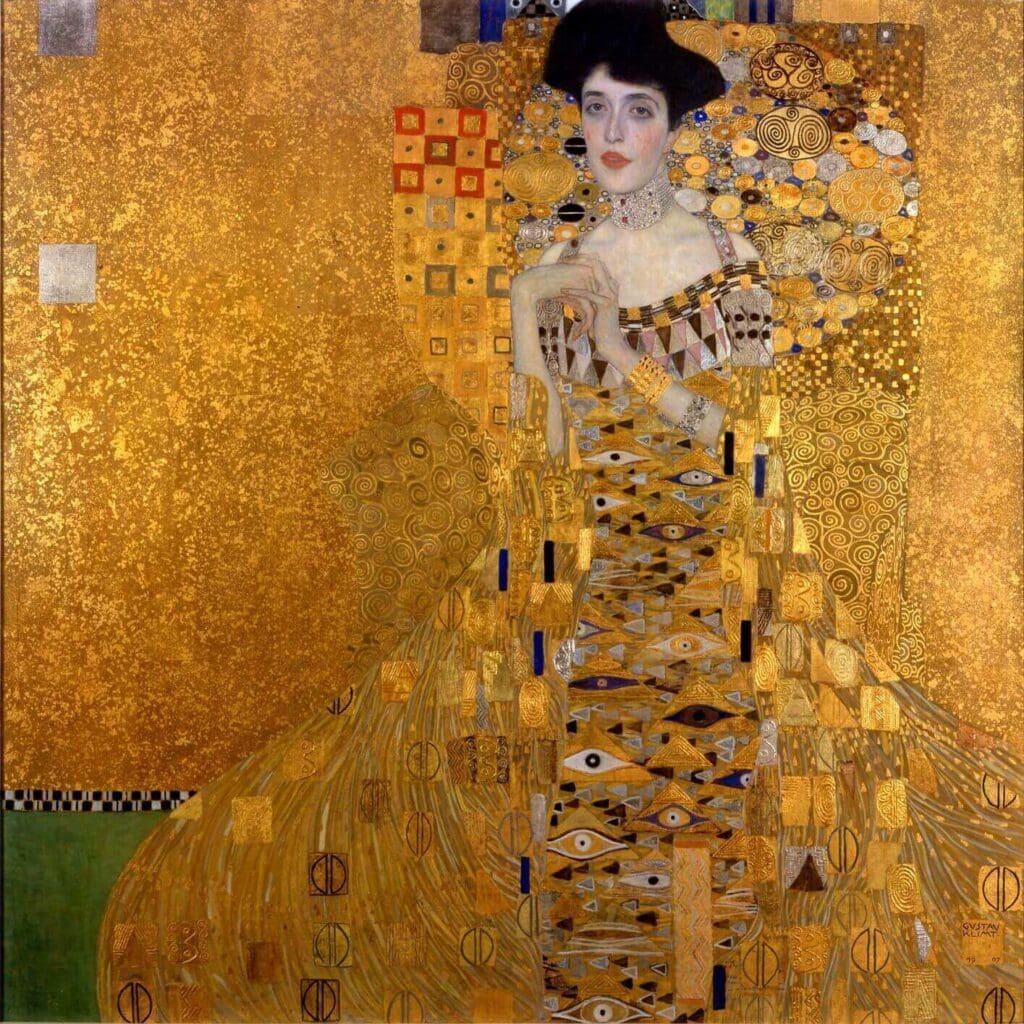
“Portrait of Adele Bloch-Bauer I,” often called the “Woman in Gold,” is one of Klimt’s most outstanding achievements. It wonderfully represents his use of gold leaf for creating high contrast and capturing his subject’s liminal and majestic quality.
It is also a testament to his unparalleled ability to fuse ornamental and figurative elements into a visually stunning piece.
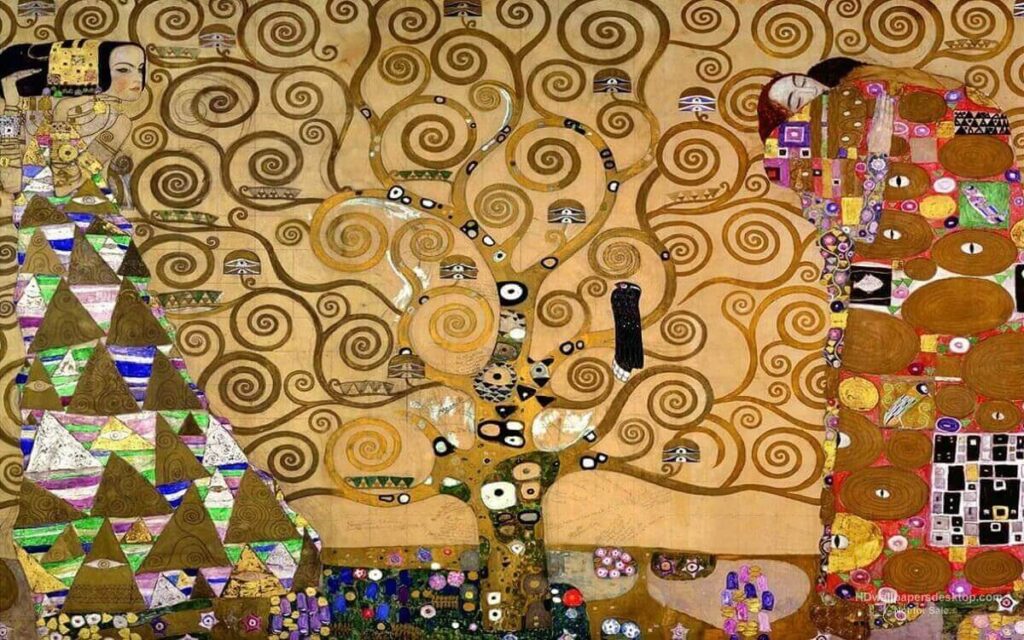
Another significant piece is “The Tree of Life,” it hails from Klimt’s later “golden” period and is one of his most symbolic paintings. It seamlessly combines many themes, including life, death, and rebirth, through a single, powerful image of a gnarled, twisted tree.
Gustav Klimt left an indelible mark on the art world with his audacious style, distinctive use of gold, complex symbolism, and authentic visual narrations. His works, rich in technique and substance, continue to captivate audiences, sparking intrigue, admiration, and discussion.
The beauty of his art lies not just in what we see but in the depths beneath that invite us to explore. And in that exploration, we learn about Klimt, the artist, and ourselves.
Gustav Klimt’s Impact on Art and Future Generations
The influence of Gustav Klimt’s work on the art world is beyond measure; a trailblazer, Klimt shook the foundations of artistic norms, opening a new landscape of aesthetic possibilities that continue reverberating within art.
Klimt’s unique style, characterized by a departure from traditional art norms and aesthetic beauty coupled with a deep exploration of the human condition, has opened up the discourse on the perception of art and what it could mean to the observer.
As one delves into his opulent and boundary-pushing oeuvre, it becomes evident that Klimt reveled in breaking free from conventional artistic restrictions. This attitude would thus reverberate through future generations of artists, urging them to explore beyond the traditional canons and conventions of art.
No exploration of Klimt’s work can be completed without mentioning his revolutionary use of gold leaf, a nod to his father’s profession as a gold engraver. The golden halos of Byzantine art and the opulent designs of Egyptian murals found echoes in Klimt’s masterpieces, adding intrigue and richness to his work.
This distinctive employment of gold leaf not only accentuated the aesthetic appeal of his work but also became one of the crucial tools for his visual storytelling.
This remarkable use of gold leaf symbolized Klimt’s sharp departure from artistic norms during his time, inspiring many contemporary artists and designers to experiment with texture and materials.
Equally groundbreaking was Klimt’s fearless incorporation of eroticism, psychology, and symbolism in his work—a true exploration of the human condition. His exploration of these elements was potent and far ahead of his times, inviting the spectator to delve into the depths of the human psyche and the complex realities of love and desire.
This insightful exploration of these themes subsequently stimulated postmodernism and psychoanalytical theory in visual arts.
The intense pattern and ornamentation in Gustav Klimt’s work highlighted narrative elements, activating areas of the canvas with decorative motifs and symbolic references.
These patterns became a playbook for artists to understand how storytelling can be reflected not just through the subjects but through the design and form of the artwork as well.
Taking a closer look at signature pieces like “The Kiss,” “Portrait of Adele Bloch-Bauer I,” and “The Tree of Life,” it becomes apparent that this remarkable artist often left his audiences with an open invitation to explore and interpret his works, acknowledging that every viewer will bring in their unique perspective to the narrative.
This respect for the viewer’s engagement with art and his thematic exploration of love, life, death, and human emotion has had a transformative impact on both artists and audiences.
Thus, without a doubt, Gustav Klimt left an indelible impact on the art world. His explorations and disruptions invited countless artists to push boundaries and laid the foundation for many art movements, including Surrealism and Symbolism.
His legacy is a testament to the transformative power of art its ability to challenge the status quo and forever alter the perception of what art can achieve. Klimt’s influence reverberates in countless aspects of contemporary art today – emphasizing viewer engagement, intense symbolism, and the exploration of the human condition.
His influential oeuvre continues to inspire and spark dialogues, underscoring his enduring relevance in the art world.
Gustav Klimt’s Later Life, Death and Posthumous Reputation
Gustav Klimt was a man of great talent and innovation who lived during an exciting and transformative time for the European art world. Following his creative peak, the later years of Klimt’s life were steeped in turmoil as the world braced for the outbreak of the First World War.
Despite increasing political uncertainty and societal unrest, this time was notably productive for Klimt, resulting in some of his most recognized masterpieces.
The onset of the 20th century marked a unique period in Klimt’s artistic journey; it signified a shift from his earlier, relatively contentious public image to that of a recognized and respected cultural icon.
While his love affairs and representation of female sensuality had previously sparked public and critical controversy, his later works were received with less dispute, indicating a broader societal acceptance of his daring creative vision.
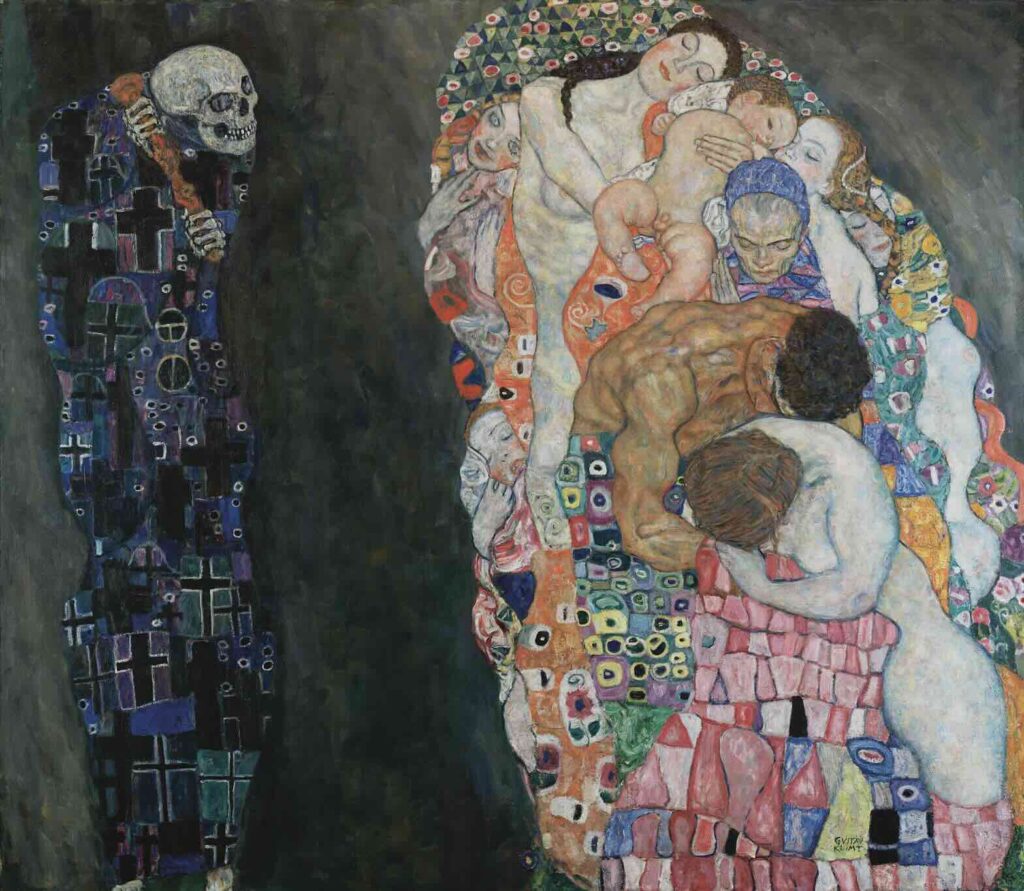
In 1911, Klimt’s painting entitled “Death and Life” was awarded the first prize at the world exhibition in Rome. Around this time, he began to delve deeply into landscapes, creating pieces showcasing his superb ability to capture the essence of nature, untouched by anthropological influence.
She presumably provided solace and inspiration against escalating international tensions during this period.
However, this fruitful period was soon cut short, as Klimt fell victim to the deadly Spanish flu pandemic sweeping across the globe in 1918.
He passed away on February 6th of that year, aged 55, leaving behind many artworks yet to be completed. His death was met with profound sadness and loss within the art community and by his legions of followers and fans.
The perception of Klimt’s work and reputation has significantly transitioned since his passing. Initially, the art establishment’s appreciation of his work was confined mainly to Austria.
However, the posthumous international retrospective exhibitions in the 20th and 21st centuries have significantly boosted his reputation abroad. From New York to Tokyo, Klimt’s exuberant style, unique vision, and extraordinary talent have been celebrated for their pioneering contribution to the art world.
Today, Klimt’s inarguable genius and the mystery and fascination surrounding his personal life have substantially elevated his posthumous reputation. His daring exploration of the human form, female sensuality, and psychological depth continue to captivate modern audiences.
His influence on fellow artists and subsequent art movements is abundantly clear, evident in the echoes of his stylistic choices and thematic explorations in later works.
Klimt’s legacy is extraordinary, as his artwork’s value continues to skyrocket. In 2006, his iconic piece, a portrait of Adele Bloch-Bauer, was sold for a record-smashing $135 million – at the time, the highest price ever paid for a painting.
Simultaneously adored by the public and acclaimed by critics, Gustav Klimt’s lasting impact reaffirms his position as a cornerstone of contemporary art history.
From his extravagant, golden portraits to his serene landscapes, Klimt conveyed a deep understanding of human nature and emotion. Passion, intimacy, terror, desire – every human experience was immortalized through his incandescent brush strokes.
An exploration into the life and works of Gustav Klimt offers an immersive journey into the visionary genius that he was and the enduring legend that he continues to be. He managed to infuse his exploration into his creative output, inviting us all on an intimate journey of his triumphs and tribulations.
Gustav Klimt’s death was a loss that reverberated across the globe; nevertheless, his legacy remains – as vibrant and profound as the golden tendrils that adorned his immortalized subjects.

The legacy of Gustav Klimt reverberates unequivocally in the art world, his influence seeping into the works of countless artists that followed.
His controversial yet captivating artistic approach, a testament to his courage and creativity, forced a reconsideration of traditional norms and pioneered a transformative art movement.
Klimt’s later years, marked by a pivot in his artistic style, his untimely death, and the consequent handling of his estate, are critical in understanding the magnitude of his lasting impact.
Such an exploration into Gustav Klimt’s life journey, artistic evolution, and enduring legacy ultimately amplifies the unwavering significance of his contribution to the annals of global art history.
Anita Louise Art is dedicated to art education, great artists, and inspiring others to find and create their art. We love art that uplifts and inspires. #ArtToMakeYouSmile! #ArtToMakeYouHappy!
If you want to see any of my art, you can find out more by clicking here. If you are interested in what inspires me and my paintings, you can discover more by clicking here.
We have a free newsletter and would love you to be part of our community; you can subscribe to the newsletter by clicking here. If you have any questions, I would be happy to talk to you. You can reach me, Anita, by clicking here.
Subscribe to our Anita Louise Art YouTube Channel, filled with great videos and information by clicking here.
Join us for our podcast “5 Minutes With Art.” Spend just 5 minutes a week with us to discover and learn about great art and artists. You can find out more about our podcast by clicking here.
Related Questions
Gustav Klimt Paint – What Paints Did Gustav Klimt Use?
Gustav Klimt’s distinctive style is instantly recognizable, characterized by intricate patterns, symbolic themes, and lavish ornamentation. Gustav Klimt employed various paints and techniques to bring his visions to life. Read on as we delve into the paints that Gustav Klimt used to create his masterpieces, providing insights into his artistic process and choices.
By clicking here, you can learn more by reading Gustav Klimt Paint – What Paints Did Gustav Klimt Use?
Gustav Klimt’s Paintings: An Intimate Glimpse Into His Genius
Gustav Klimt is widely regarded as one of the most influential artists of the 20th century. His innovative and daring approach to art and unique style and vision have made him an icon in modern art. Klimt’s paintings are celebrated for their sensuality, symbolism, and intricate details, which have captivated audiences for over a century.
By clicking here, you can learn more by reading Gustav Klimt’s Paintings: An Intimate Glimpse Into His Genius.
The Timeless Legacy Of Gustav Klimt’s Paintings
Gustav Klimt was a groundbreaking Austrian artist whose work continues to captivate audiences worldwide. His bold and innovative approach to art and his use of symbolism and sensuality have made him one of the most iconic artists of the modern era. Klimt’s legacy has profoundly influenced the art world and continues to inspire artists today.
By clicking here, you can learn more by reading The Timeless Legacy Of Gustav Klimt’s Paintings.

